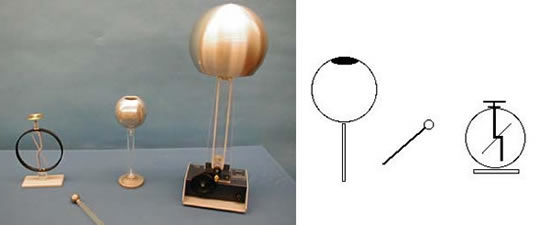Demos: 5A-12 Gauss' Law: Charge Within a Conductor

A hollow metal sphere with a top opening is attached to an electrostatic generator and charged. The connection is removed and a test sphere is touched to the outside surface of the sphere. When the test sphere touches the knob of the electroscope, it shows that the test sphere has been charged. After grounding both the electroscope and the test sphere, the latter is placed INSIDE the hollow sphere and touched to the inside surface. The test sphere is removed and placed against the electroscope. No charge is detected, illustrating that the charge resides only on the outer surface of the conductor.
Directions: Charge the hollow sphere by connecting it to the electrostatic generator. Once it is charged, remove the connection. Ground the test sphere, then touch it to the outside of the hollow sphere. Carefully move it to the electroscope (previously grounded) and touch it to the knob.
Repeat the process above, except this time touch the test sphere to the inside wall of the hollow sphere.
Suggestions for Presentation: Ask the students where the charge actually resides in a metal. Suggest that because the metal is a good conductor, charges should be free to roam anywhere. Therefore, charge ought to be found anywhere on the sphere. That no charge is inside the sphere may come as a surprise to many.
Applications: This is related to electrostatic shielding.
Last Updated: Nov 30, 2023 11:25 AM